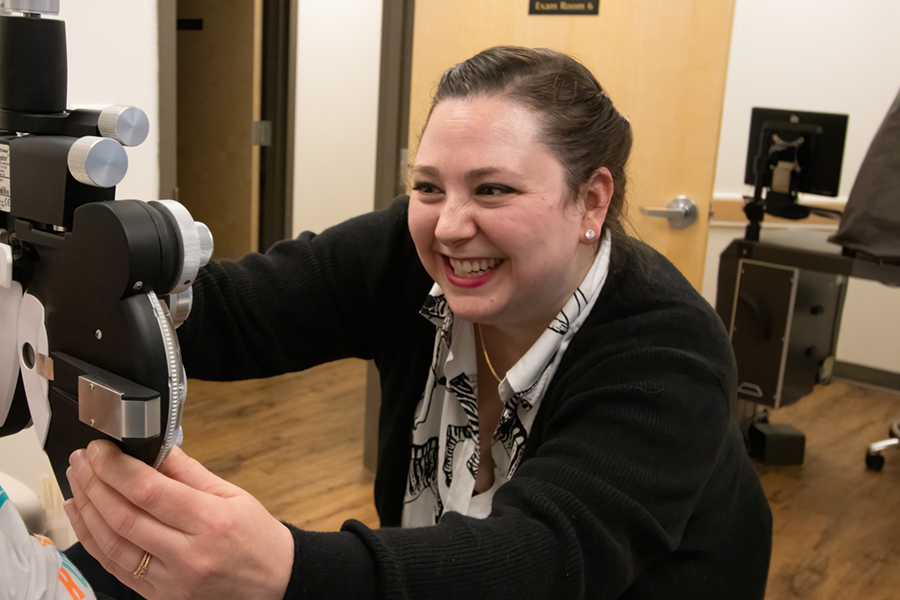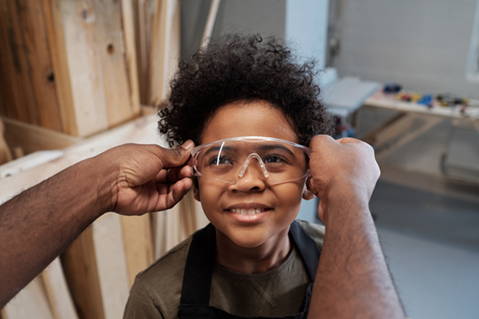Children’s Eye Exams
Vision Examinations for Children

When parents fail to get regular vision examinations for their children, they are putting more than eyesight at risk-they are threatening their children’s educational development as well. One out of every four children from ages five to 12 has a vision problem that could affect their educational performance. While parents often are quick to schedule regular physical checkups for their children, they might overlook the importance of a professional eye examination. Screenings offered at schools are designed to identify problems with a child’s vision. However, they simply are not thorough enough to expose problems of eye muscle coordination, eye disease or peripheral vision or short-comings in near-distance vision—areas very important to the learning process.
Parents should not wait until their children report visual problems. With some visual skills reaching full development at about 5 years of age, correction after this point becomes more difficult. Visual defects discovered before this age can be treated; therefore it is vital for parents to schedule regular eye examinations as recommended by the American Optometric Association. Parents should pay attention to these indications that a child might be experiencing problems:
- squinting
- reading from books held unusually close to the face
- eyes pointing in different directions
- twisting or tilting of the head to favor one eye
- headaches and dizziness
- blurred or double vision
- ability to read only for a short period of time
- frequent blinking or rubbing of eyes
- inability to judge distance properly (bumping into things)
- using a finger to follow words when reading
- poor school performance
- poor athletic performance
A child’s eye examination involves the comprehensive testing of anatomical, functional and perceptual development. It usually begins with a review of the family’s medical history (some visual problems are hereditary), a review of the child’s visual history, and a test to check for visual acuity or clarity of vision. Your child will also be dilated with drops that affect your childs ability to accommodate resulting in a more accurate glasses determination. Our physician will perform an external examination for structural anomalies such as the position of the eye in the socket and the extent of tearing and lubrication. This is followed by an internal examination in which the doctor uses an ophthalmoscope to look into the eye and examine the retina or inner lining of the eye. Subsequent testing can check the child’s ability to interpret color information and visually track a moving object. Children may even be screened for glaucoma.
Near Sightedness (Also known as Myopia)
Nearsightedness, medically referred to as myopia, is where you can see objects that are near to you, but objects that are far away appear blurred. Children who are nearsighted may complain of headaches, or you may notice them squinting when playing sports, or watching TV. They may do poorly at school because they cannot see the material on the blackboard clearly. Call our office and schedule an appointment today if you suspect your child is experiencing any of these symptoms. Nearsightedness is a common problem that has a tendency to run in families and can affect girls and boys equally. Nearsightedness may be corrected with glasses, contact lenses or refractive surgery.
Nearsightedness can progress quickly in children, which is why regular eye examinations are important.
Far Sightedness (Also known as Hyperopia)
Farsightedness, which is medically referred to as Hyperopia, is a vision problem in which objects that are close appear blurred, and objects in the distance appear normal. Children may have difficulty when reading or writing, both appearing fuzzy and blurred.
Call our office and schedule an appointment today if you suspect your child is experiencing any of these symptoms.
Farsightedness can be corrected with glasses or contact lenses. Children may need to wear their corrective lenses all the time, or just when doing tasks close up.
UV Protection for Children

Children may not be as interested as adults are in the fashion aspect of sunglasses. However, they need sun protection just as much as adults do and sometimes even more, since they are spending more time playing outdoors and in direct sunlight and are therefore more susceptible to harmful UV rays. The sun can do as much damage to your eyes as it can to your skin. This is especially true for children, whose risk is higher because the lens in their eye doesn’t filter as much UV light and because they spend so much time outside.
With that in mind, here are a few important points to keep in mind before you send your child out to play.
- 80% of a person’s lifetime exposure to UV occurs before age 18
- The lens’ in children’s eyes does not block as many UV rays as they do in adults’ eyes, putting them at increased risk for sun damage to the eyes
- Although 82% of parents feel it is important for children to wear sunglasses and 91% feel sunscreen should be worn, children are two times more likely to wear sunscreen than they are sunglasses.
- Almost 50% of parents report that their children “seldom” or “never” wear sunglasses with 100% UV protection.
Computer Vision Syndrome
Many American children spend one to three hours per day on the computer, talking online, playing games, or doing homework. Children are encouraged to use the computer at ages two and three. A child’s eyes can become stressed when sitting in front of a computer screen for long periods of time because the computer can force the child’s vision to focus and strain more than any other task. Parents need to be aware of the vision problems associated with computer work. Computer use forces fine motor skills from children whose young eyes are not well developed. Not until the visual system matures is the child able to effectively handle the stress of computers.
According to the American Optometric Association, the influence of computer use on a child’s vision involves these factors:
- Children have a narrow degree of self-awareness. They may be on a computer for hours with a small number of breaks. This extended activity can cause eye focusing and eye strain problems.
- Children are incredibly adaptable. They assume that what they how they see is normal – even if their vision is not. It is important for parents to monitor the time a child spends at a computer.
- Children are smaller than adults. Computer workstations are usually set for adult use, this changes the viewing angle for children. Computer users should view the screen slightly downward. Children may experience neck, shoulder and/or back pain, because they have difficulty reaching the keyboard or placing their feet on the floor.
Eye doctors deem that environmental stress of the indoor world rather than genetics is creating a nearsightedness epidemic. In fact, children who use computers before their visual systems are fully developed are susceptible to computer vision syndrome. CVS can be prevented by annual eye examinations, setting up computer workstations that will fit a child, position the monitor correctly, and watch your child closely. If you notice your child running their eyes frequently, tilting their heads, or their eyes are red , among other symptoms, call our office and schedule an appointment today, don’t take any chances with your child’s eyes.
Eye Safety for Children

Most childhood accidents occur at home, many with toys. Children spend a great deal of time playing with their toys, so you need to make sure those toys are safe for eyes. Avoid toys that shoot objects in the air, such as slingshots, dart guns or arrows, for children under 6, and closely supervise any child playing with such toys. If your older child plays with a chemistry set or woodworking tools, give him or her safety goggles.
Sports-related eye injuries are topping 100,000 per year, and almost all are preventable by protective eyewear . Children are especially vulnerable to an eye injury because they don’t know that their vision, and possibly a lifetime of healthy vision, is at stake. For children, eye injuries happen mainly while playing. They should wear eye protection for any sports and recreational activities that uses a projectile or racket, involves rough contact with other players, or requires travel at high speed. Ask an eye doctor about the best eye protection for your child.

